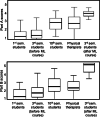Testing a new active learning approach to advance motor learning knowledge and self-efficacy in physical therapy undergraduate education
- PMID: 33468119
- PMCID: PMC7816454
- DOI: 10.1186/s12909-021-02486-1
Testing a new active learning approach to advance motor learning knowledge and self-efficacy in physical therapy undergraduate education
Abstract
Background: Motor learning (ML) science is foundational for physical therapy. However, multiple sources of evidence have indicated a science-practice gap. Clinicians report low self-efficacy with ML concepts and indicate that the lack of access to systematic training is a barrier for practical implementation. The general goal of this preliminary study was to describe the effects of a new educational intervention on physical therapy student's ML self-efficacy and knowledge.
Methods: Self-efficacy was assessed with the Physical Therapists' Perceptions of Motor Learning questionnaire. Data was acquired from third-semester students before their participation in the ML educational intervention. Reference self-efficacy data was also acquired from physical therapy professionals and first and last-semester students. The educational intervention for third-semester students was designed around an established framework to apply ML principles to rehabilitation. A direct experience, the "Learning by Doing" approach, in which students had to choose a motor skill to acquire over 10 weeks, provided the opportunity to apply ML theory to practice in a personally meaningful way. After the intervention self-efficacy was re-tested. ML knowledge was tested with an objective final exam. Content analysis of coursework material was used to determine how students comprehended ML theory and related it to their practical experience. The Kruskal-Wallis and Mann-Whitney U tests were used to compare self-efficacy scores between the four groups. Changes in self-efficacy after the educational intervention were analyzed with the Wilcoxon test. Spearman rank correlation analysis was used to test the association between self-efficacy and final exam grades.
Results: By the end of the intervention, students' self-efficacy had significantly increased (p < 0.03), was higher than that of senior students (p < 0.00) and experienced professionals (p < 0.00) and correlated with performance on an objective knowledge test (p < 0.03). Content analysis revealed that students learned to apply the elements of ML-based interventions present in the scientific literature to a real-life, structured ML program tailored to personal objectives.
Conclusions: Positive improvements were observed after the intervention. These results need confirmation with a controlled study. Because self-efficacy mediates the clinical application of knowledge and skills, systematic, active training in ML may help reduce the science-practice gap.
Keywords: Active learning; Education; Motor learning; Physical therapy.
Conflict of interest statement
The authors declare that they have no competing interests.
Figures




Similar articles
-
Assessing the impact of a knowledge translation intervention on physical therapists' self-efficacy and implementation of motor learning practice.BMC Med Educ. 2023 May 23;23(1):369. doi: 10.1186/s12909-023-04304-2. BMC Med Educ. 2023. PMID: 37221530 Free PMC article.
-
The effectiveness of internet-based e-learning on clinician behavior and patient outcomes: a systematic review protocol.JBI Database System Rev Implement Rep. 2015 Jan;13(1):52-64. doi: 10.11124/jbisrir-2015-1919. JBI Database System Rev Implement Rep. 2015. PMID: 26447007
-
Effectiveness of high fidelity simulation versus low fidelity simulation on practical/clinical skill development in pre-registration physiotherapy students: a systematic review.JBI Database System Rev Implement Rep. 2019 Jun;17(6):1229-1255. doi: 10.11124/JBISRIR-2017-003931. JBI Database System Rev Implement Rep. 2019. PMID: 30964770
-
Promoting physical therapists' use of research evidence to inform clinical practice: part 3--long term feasibility assessment of the PEAK program.BMC Med Educ. 2016 May 12;16:144. doi: 10.1186/s12909-016-0654-9. BMC Med Educ. 2016. PMID: 27176726 Free PMC article.
-
Impact of summer programmes on the outcomes of disadvantaged or 'at risk' young people: A systematic review.Campbell Syst Rev. 2024 Jun 13;20(2):e1406. doi: 10.1002/cl2.1406. eCollection 2024 Jun. Campbell Syst Rev. 2024. PMID: 38873396 Free PMC article. Review.
Cited by
-
Assessing Impairments in Visuomotor Adaptation After Stroke.Neurorehabil Neural Repair. 2022 Jul;36(7):415-425. doi: 10.1177/15459683221095166. Epub 2022 May 26. Neurorehabil Neural Repair. 2022. PMID: 35616370 Free PMC article.
-
Assessing the impact of a knowledge translation intervention on physical therapists' self-efficacy and implementation of motor learning practice.BMC Med Educ. 2023 May 23;23(1):369. doi: 10.1186/s12909-023-04304-2. BMC Med Educ. 2023. PMID: 37221530 Free PMC article.
References
-
- American Physical Therapy Association (APTA). Vision Statement for the Physical Therapy Profession and Guiding Principles to Achieve the Vision. http://www.apta.org/Vision/. Accessed 7 Mar 2017.
-
- World Confederation for Physical Therapy (WCPT). Guideline for physical therapist professional entry level education. Pubished 2017. https://www.wcpt.org/sites/wcpt.org/files/files/Guideline_PTEducation_co.... Accessed 7 Mar 2017.
-
- Kleynen M, Moser A, Haarsma FA, Beurskens AJ, Braun SM. Physiotherapists use a great variety of motor learning options in neurological rehabilitation, from which they choose through an iterative process: a retrospective think-aloud study. Disabil Rehabil. 2017;39(17):1729–1737. doi: 10.1080/09638288.2016.1207111. - DOI - PubMed
MeSH terms
Grants and funding
LinkOut - more resources
Full Text Sources
Other Literature Sources
Miscellaneous

